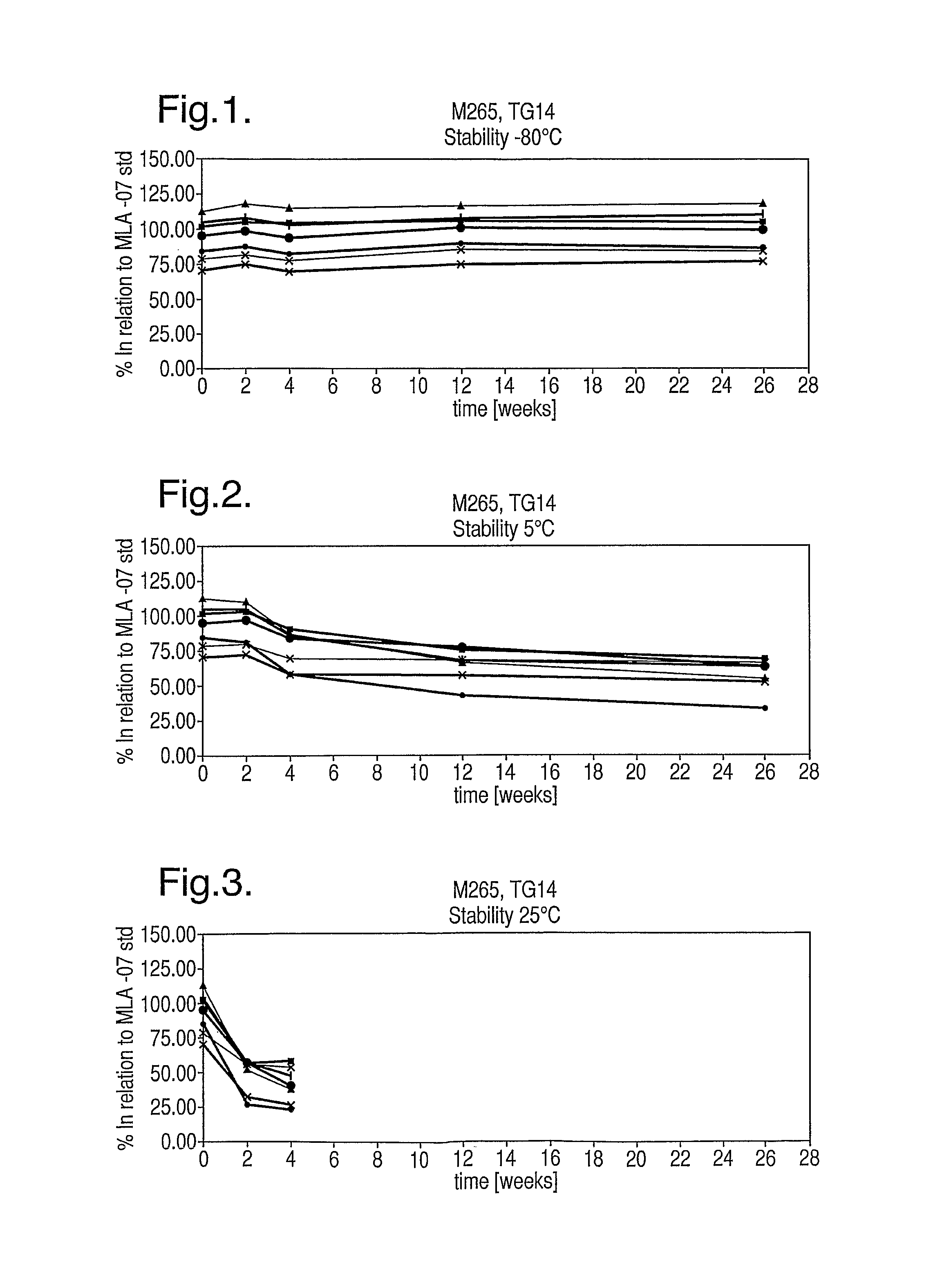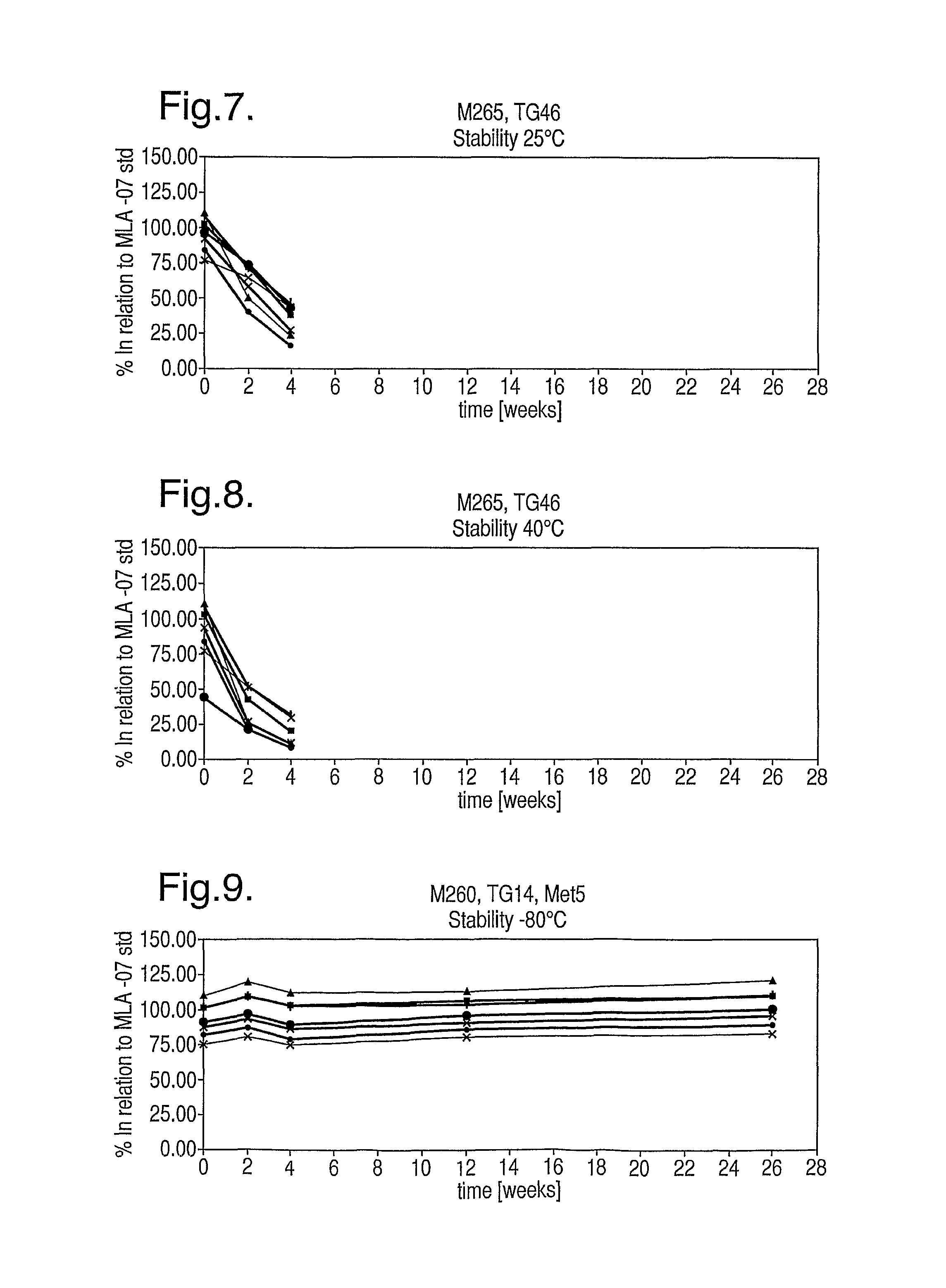Compositions with reduced dimer formation
a dimer and dimer technology, applied in the field of compositions with reduced dimer formation, can solve the problems of perishable materials, less well-known, and damage to the material to be preserved, and achieve the effects of reducing the number of dimers, and reducing the formation rate of dimers
- Summary
- Abstract
- Description
- Claims
- Application Information
AI Technical Summary
Problems solved by technology
Method used
Image
Examples
example 1
Trehalose Formulation
Typical Freeze-Drying Cycle
[0146]
ShelfChamber pressureDurationStepTemp (° C.)(mbar)(h · min)120100002−40100000.363−4010001.304−240.052.005−240.0524.006240.059.207240.056.00
[0147]Non-peptide components (values in brackets indicate concentrations in mM) trehalose / thioglycerol / methionine (250:46:5).
Characteristics
Tg′=−31.9° C.
Tg=83-87° C. (first run)
Residual moisture=nd
WAXS diffractogram: fully amorphous
[0148]Retention of thioglycerol is excellent. No condensation is visible on vial walls for all storage conditions. The thioglycerol is evidently immobilised within the amorphous cake.
[0149]Cake appearance is cracked and so not aesthetically pleasing, but storage stability is excellent as shown in FIGS. 17 to 19. No significant peptide degradation was observed apart from for the most extreme conditions tested (40° C. / 75% RH) after approx. 8 weeks.
example 2
‘Amorphous’ Binary Mixture Series
Typical Freeze-Drying Cycle
[0150]
ShelfChamber pressureDurationStepTemp (° C.)(mbar)(h · min)1−40100002−4010001.003−150.030.304−150.0320.005300.030.256300.038.00
2A
[0151]Non-peptide components (values in brackets indicate concentrations in mM) trehalose / glycine / thioglycerol / methionine (165:95:46:5)
Characteristics
Tg′=−36.7° C.
Tg=62.5° C.
Residual moisture=0.61% w / v
Cake structure: fully amorphous
[0152]Retention of thioglycerol is excellent. No condensation is visible on vial walls for all storage conditions. The thioglycerol is evidently immobilised within the amorphous cake.
[0153]Cake appearance is cracked and so not aesthetically pleasing, but storage stability is excellent as shown in FIGS. 20 to 23. No significant peptide degradation was observed apart from for the most extreme conditions tested (40° C. / 75% RH), at which continual decline in peptide content was observed.
2B
[0154]Non-peptide components (values in brackets indicate concentrations in mM) ...
example 4
[0213]A formulation based on the findings of Example 1 was tested further for long-term stability. The following formulation (called Thioglycerol “high”) was stored for up to one year at 30° C. / 65% RH:
[0214]
Raw materialFunctionNominal concentration1MLA01, acetate saltActive ingredient50μM73.8μg / mLMLA03, acetate saltActive ingredient50μM88.6μg / mLMLA04, acetate saltActive ingredient50μM94.0μg / mLMLA05, acetate saltActive ingredient50μM101.1μg / mLMLA07, acetate saltActive ingredient50μM90.3μg / mLMLA12, acetate saltActive ingredient50μM91.3μg / mLMLA14, acetate saltActive ingredient50μM84.7μg / mLD(+) TrehaloseTonicity agent270mM102.149mg / mLdihydrate1-ThioglycerolReducing agent46mM1.514mg / mLL-MethionineAntioxidant5mM0.746mg / mLPhosphoric acidpH adjustmentAs required
[0215]Concentrations are given for the composition when in a liquid state, that is before freeze drying and after reconstitution. An alternative formulation (Thioglycerol “low”) was tested under the same conditions, and was identical...
PUM
| Property | Measurement | Unit |
|---|---|---|
| temperature | aaaaa | aaaaa |
| eutectic temperatures | aaaaa | aaaaa |
| time | aaaaa | aaaaa |
Abstract
Description
Claims
Application Information
 Login to View More
Login to View More - R&D
- Intellectual Property
- Life Sciences
- Materials
- Tech Scout
- Unparalleled Data Quality
- Higher Quality Content
- 60% Fewer Hallucinations
Browse by: Latest US Patents, China's latest patents, Technical Efficacy Thesaurus, Application Domain, Technology Topic, Popular Technical Reports.
© 2025 PatSnap. All rights reserved.Legal|Privacy policy|Modern Slavery Act Transparency Statement|Sitemap|About US| Contact US: help@patsnap.com



